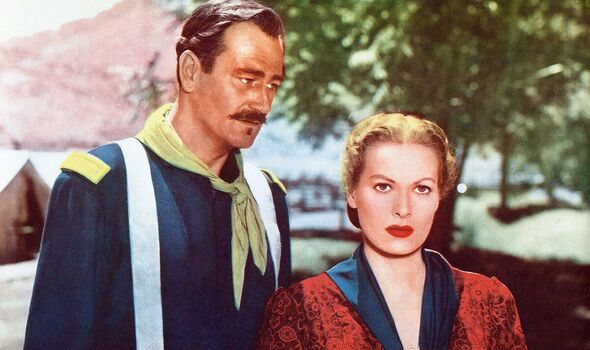The golden age of Hollywood is replete with tales of cinematic grandeur and on-set challenges, but few are as persistently intriguing as the alleged tragedy surrounding John Wayne’s 1950 Western, “Rio Grande.” This iconic film, the third in John Ford’s revered Cavalry Trilogy, alongside “Fort Apache” and “She Wore a Yellow Ribbon,” reportedly harbored a dark secret, a claim of cast fatalities that remains a subject of historical debate.
At the heart of this contentious narrative is legendary actress Maureen O’Hara, John Wayne’s celebrated co-star in “Rio Grande.” In her candid autobiography, “‘Tis Herself,” O’Hara recounted a harrowing incident during the film’s production. She asserted that two stuntmen met a tragic end, purportedly drowning in a muddy river scene after falling from their horses, their bodies never recovered due to the thick sediment and the lack of witnesses to their demise.
The challenging conditions of the Utah filming location for “Rio Grande” are well-documented, with extreme heat posing significant obstacles for both the cast and crew. Constructing sets and stages in such an unforgiving environment undoubtedly added to the arduous nature of the production, making a physically demanding sequence even more perilous, though the specific circumstances of the alleged drownings are still questioned.
Despite O’Hara’s vivid recounting, the veracity of her claims has been widely contested by film historians and those closely associated with the production. Michael F. Blake’s scholarly work, “The Cavalry Trilogy,” points to a significant absence of corroborating evidence. Crucially, no independent proof has surfaced from contemporary newspaper archives or official film production files to substantiate the alleged fatalities on the “Rio Grande film” set.
Further casting doubt on the grim anecdote, actor Harry Carey Jr., when questioned by Blake before his passing, directly contradicted O’Hara’s account. Carey Jr., a participant in the production, stated unequivocally that no cast members died during the filming of “Rio Grande.” He acknowledged only one stunt-related injury, that of Chuck Hayward, indicating a stark divergence from O’Hara’s dramatic recollection regarding this classic Western.
Beyond the somber discussions of on-set accidents, “Rio Grande” marked a pivotal collaboration for John Wayne, his first of five starring roles opposite Maureen O’Hara, solidifying their iconic on-screen chemistry. Even amidst the rigorous production, subtle details like John Wayne’s use of a smaller toupee to portray his Lieutenant Colonel Kirby Yorke character’s age demonstrate the meticulous attention to detail within these Hollywood legends.
An amusing anecdote from the set, far removed from the claims of tragedy, illustrates director John Ford’s playful side and the camaraderie among the crew. Ford reportedly hired actor Alberto Morin to impersonate a French waiter, whose clumsy antics—accidentally breaking plates and spilling soup on executives—provided comic relief, unbeknownst to the unsuspecting studio suits, highlighting the lighter moments during the arduous shoot.
The enduring mystery surrounding the alleged “Rio Grande” set deaths continues to intrigue enthusiasts of film history. While Maureen O’Hara’s memoir offers a compelling, albeit unverified, account, the lack of official documentation and counter-testimony from fellow cast members leaves the true events shrouded in uncertainty. This cinematic tale, much like the challenging landscape it depicted, holds layers of stories, some perhaps forever lost in the annals of Hollywood lore.






Leave a Reply